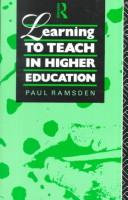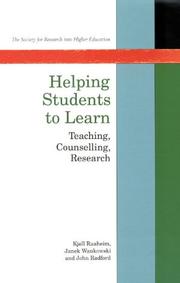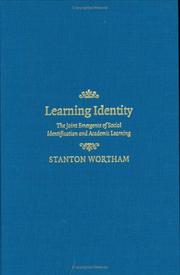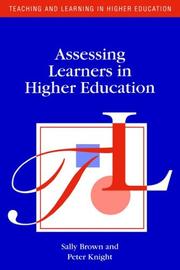| Listing 1 - 6 of 6 |
Sort by
|

ISBN: 2738441246 Year: 1996 Publisher: Paris : Editions L'Harmattan,
Abstract | Keywords | Export | Availability | Bookmark
 Loading...
Loading...Choose an application
- Reference Manager
- EndNote
- RefWorks (Direct export to RefWorks)
Book
ISBN: 0719031788 071903180X Year: 1990 Publisher: Manchester : Manchester University Press,
Abstract | Keywords | Export | Availability | Bookmark
 Loading...
Loading...Choose an application
- Reference Manager
- EndNote
- RefWorks (Direct export to RefWorks)

ISBN: 0415064155 0415064147 9780415064156 9780415064149 Year: 1992 Publisher: London : Routledge,
Abstract | Keywords | Export | Availability | Bookmark
 Loading...
Loading...Choose an application
- Reference Manager
- EndNote
- RefWorks (Direct export to RefWorks)
Didactic strategies --- Didactics of higher education --- lesgeven --- PGO (probleemgestuurd onderwijs) --- College teaching --- Enseignement universitaire --- Sciences de l'éducation --- Cas, Etudes de --- didactiek naar onderwijsniveau en leerlingkenmerken --- didactiek naar onderwijsniveau en leerlingkenmerken. --- Didactiek naar onderwijsniveau en leerlingkenmerken. --- Sciences de l'éducation --- -College teaching --- -University teaching --- Teacher education. Teacher's profession --- HO (hoger onderwijs) --- Case studies. --- Pedagogiek en onderwijskunde --- Didactiek. --- Case studies --- Education --- Study and teaching. --- Great Britain --- Australia --- College teaching - Great Britain. --- College teaching - Australia. --- College teaching - Great Britain - Case studies. --- College teaching - Australia - Case studies. --- University teaching --- Teaching

ISBN: 0335093191 0335093205 9780335093199 9780335093205 Year: 1991 Publisher: Buckingham: Open university press,
Abstract | Keywords | Export | Availability | Bookmark
 Loading...
Loading...Choose an application
- Reference Manager
- EndNote
- RefWorks (Direct export to RefWorks)
Study methods --- Counseling in higher education --- College student orientation --- College teaching --- Study skills --- How to study --- Learning, Art of --- Method of study --- Study, Method of --- Life skills --- Academic advising --- College counseling --- College guidance --- College students --- Guidance in higher education --- Higher education counseling --- Higher education guidance --- Personnel service in higher education --- Education, Higher --- Student affairs services --- University teaching --- Teaching --- College orientation --- Orientation, College student --- Student orientation, College --- College student development programs --- Counseling of --- Orientation --- College student orientation. --- College teaching. --- Counseling in higher education. --- Study skills. --- Pedagogiek en onderwijskunde --- didactiek naar onderwijsniveau en leerlingkenmerken --- didactiek naar onderwijsniveau en leerlingkenmerken.

ISBN: 9780521845885 0521845882 9780521608336 0521608333 9780511810015 1107152208 1280515929 0511810016 0511191383 0511167636 0511311664 0511135076 0511137249 9780511137242 9780511191381 9780511167638 9780511311666 9780511135071 9781280515927 9786610515929 6610515921 9781107152205 Year: 2006 Publisher: Cambridge ; New York, NY : Cambridge University Press,
Abstract | Keywords | Export | Availability | Bookmark
 Loading...
Loading...Choose an application
- Reference Manager
- EndNote
- RefWorks (Direct export to RefWorks)
This book describes how social identification and academic learning can deeply depend on each other, both through a theoretical account of the two processes and a detailed empirical analysis of how students' identities emerge and how students learn curriculum over a year in one classroom. The book traces the identity development of two students, showing how they came habitually to occupy characteristic roles across an academic year. The book also traces two major themes from the curriculum, showing how students came to make increasingly sophisticated arguments about them. The book's distinctive contribution is to show in detail how social identification and academic learning became deeply interdependent. The two students developed unexpected identities in substantial part because curricular themes provided categories that teachers and students used to identify them. And students learned about those curricular themes in part because the two students were socially identified in ways that illuminated those themes.
Educational sociology. --- Identity (Psychology). --- Social psychology. --- Pedagogiek en onderwijskunde --- didactiek naar onderwijsniveau en leerlingkenmerken. --- Identity (Psychology) --- Personal identity --- Personality --- Self --- Ego (Psychology) --- Individuality --- Mass psychology --- Psychology, Social --- Human ecology --- Psychology --- Social groups --- Sociology --- Education and sociology --- Social problems in education --- Society and education --- Sociology, Educational --- Education --- Aims and objectives --- Health Sciences --- Psychiatry & Psychology

Abstract | Keywords | Export | Availability | Bookmark
 Loading...
Loading...Choose an application
- Reference Manager
- EndNote
- RefWorks (Direct export to RefWorks)
College students --- -Educational tests and measurements --- -Educational assessment --- Educational measurements --- Mental tests --- Tests and measurements in education --- Psychological tests for children --- Psychometrics --- Students --- Examinations --- Psychological tests --- College life --- Universities and colleges --- University students --- Rating of --- -Rating of --- Education --- Educational tests and measurements --- Pedagogiek en onderwijskunde --- Didactiek naar onderwijsniveau en leerlingkenmerken. --- Tests et mesures en éducation
| Listing 1 - 6 of 6 |
Sort by
|

 Search
Search Feedback
Feedback About UniCat
About UniCat  Help
Help News
News